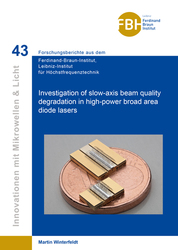| Departments | |
|---|---|
| Book Series (96) |
1378
|
| Nachhaltigkeit |
3
|
| Gesundheitswesen |
1
|
| Humanities |
2364
|
| Natural Sciences |
5406
|
| Mathematics | 229 |
| Informatics | 319 |
| Physics | 980 |
| Chemistry | 1363 |
| Geosciences | 131 |
| Human medicine | 243 |
| Stomatology | 10 |
| Veterinary medicine | 108 |
| Pharmacy | 147 |
| Biology | 835 |
| Biochemistry, molecular biology, gene technology | 121 |
| Biophysics | 25 |
| Domestic and nutritional science | 45 |
| Agricultural science | 1004 |
| Forest science | 201 |
| Horticultural science | 20 |
| Environmental research, ecology and landscape conservation | 148 |
| Engineering |
1793
|
| Common |
98
|
|
Leitlinien Unfallchirurgie
5. Auflage bestellen |
|
Advanced Search
Investigation of slow-axis beam quality degradation in high-power broad area diode lasers (Volume 43) (English shop)
Martin Winterfeldt (Author)Preview
Extract, PDF (150 KB)
Table of Contents, PDF (48 KB)
Modern high-power broad area (BA) diode lasers are important building blocks for the materials processing industry, combining high optical output power with high conversion efficiency. However, their use in direct diode systems, e.g. for sheet metal cutting, is limited due to a poor lateral (slow-axis) beam quality, which is inversely proportional to the beam parameter product (BPP).
The main objective of this work was therefore on root cause analy-sis of the factors influencing the diode lasers’ increase in lateral BPP. Hence, a series of diagnostic experiments was conducted, each aiming at a specific potential influence in order to assess its importance. The list of considered effects includes thermal lens shape, epitaxial layer design, lateral carrier profile, process-induced index guiding via dry etched trenches, filamentation, and mechanical strain. Analysis revealed that epitaxial layer structure and chip geometry have considerable impact on thermal lens bowing, which directly correlates with the rate of BPP increase with rising junction temperature. In addition, the suppression of lateral carrier accumulation with deep proton implantation at the BA emitter edges led to a 33% decrease of that deterioration rate. The application of index guiding trenches yielded stabilized near-field dimensions as function of current, but also increased the BPP considerably. Filamentation and mechanical strain were found to have only marginal influence.
In addition, this work assesses techniques that aim at reducing the BPP via a reduction of the number of active lateral modes. As a result of a near-field-width selective loss mechanism, diode lasers with an excellent linear radiance of 4.4 W/mm•mrad were fabricated.
| ISBN-13 (Hard Copy) | 9783736997332 |
| ISBN-13 (eBook) | 9783736987333 |
| Final Book Format | A5 |
| Language | English |
| Page Number | 158 |
| Lamination of Cover | matt |
| Edition | 1. |
| Book Series | Innovationen mit Mikrowellen und Licht. Forschungsberichte aus dem Ferdinand-Braun-Institut, Leibniz-Institut für Höchstfrequenztechnik |
| Volume | 43 |
| Publication Place | Göttingen |
| Place of Dissertation | TU Berlin |
| Publication Date | 2018-03-06 |
| General Categorization | Dissertation |
| Departments |
Physics of condensed matter (including physics of solid bodies, optics)
|
| Keywords | modern high power broad area diode lasers, BAL, diodes systems, BPP, active lateral modes |








